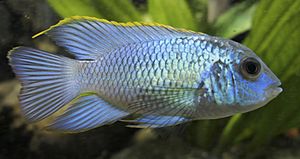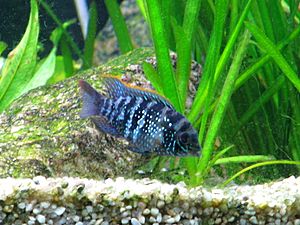Blue acara facts for kids
Quick facts for kids Blue acara |
|
|---|---|
 |
|
| An “electric blue” morph acara | |
| Conservation status | |
| Scientific classification | |
| Synonyms | |
|
The blue acara (scientific name: Andinoacara pulcher) is a beautiful freshwater fish. It belongs to the cichlid family, which includes many popular aquarium fish. You can find blue acaras in the fresh waters of Venezuela and Trinidad. They live in different places, from calm ponds to moving streams.
These fish can grow up to about 16 centimeters (about 6 inches) long. Their scientific name, pulcher, comes from Latin and means "beautiful." This name really fits them! Blue acaras are often sold in pet stores. Sometimes, people confuse them with a similar but larger fish called the green terror.
Blue acaras have a strong, compact body. They are usually a steel blue-gray color. You might see green lines on their faces. Their scales shimmer with a blue-green sparkle. They also have long, flowing fins, often with a hint of orange at the tips.
These fish come from a tropical climate. They like warm water, usually between 22 and 30 degrees Celsius (72-86°F). They also prefer water that is not too acidic or too basic, with a pH of 6.5-8.0.
What Does a Blue Acara Look Like?
Blue acaras usually grow to about 13 centimeters (5 inches) long. Some can even reach up to 16 centimeters (6 inches). Their bodies are solid and compact. They have long, graceful fins. Their heads are a bit rounder than some other cichlids.
The main color of a blue acara can change. It might be brown, blue, or even black. This depends on where the fish lives. Their bodies often have five to eight dark stripes. These stripes might not always be easy to see. They also have shiny blue spots. On their faces, you can see a few horizontal green lines.
The tips of their fins often have a touch of orange. Some blue acaras even have a red edge on their top fin. A special black line runs from their eye down their cheek. This unique line helps tell them apart from other similar fish.
Where Do Blue Acaras Come From?
Blue acaras were once placed in a different group of fish called Aequidens. But in 2009, scientists moved them to a new group called Andinoacara. This change happened because scientists learned more about how these fish are related.
See also
 In Spanish: Andinoacara pulcher para niños
In Spanish: Andinoacara pulcher para niños



